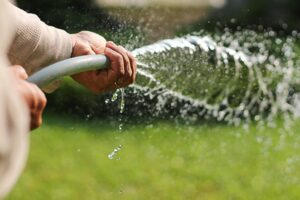8 Summer Lawn Care Tips for Vibrant Lawns
About 8 Summer Lawn Care Tips for Vibrant Lawns
Summer Lawn Care Tips for a Vibrant, Healthy Yard
Warmer weather and sunny days are synonymous with spending more time outside and enjoying your yard. But summer also creates conditions that put serious strain on your lawn, including high temperatures, limited rainfall, aggressive weeds, and hungry pests. Without proper attention, your vibrant, green grass can quickly turn thin, dry, or patchy, leaving your lawn looking tired during the months you want to enjoy it most.
So, to help you protect and maintain your lawn through the toughest stretch of the year, we’re sharing our top summer lawn tips on watering, mowing, fertilizing, and controlling weeds and pests to keep your yard healthy and vibrant all summer.
8 Summer Lawn Care Tips to Keep Your Lawn Thriving
During summer, high-end properties deserve attention to detail beyond basic upkeep, focusing on smart, preventive steps that keep stress levels low and appearance high. Below are expert-backed lawn maintenance tips for summer designed to help your lawn stay strong and beautiful during the warmest months of the year.
1. Water Smart, Not Often
Water is arguably the most important resource your lawn needs, and it’s coincidentally what tends to run short during peak summer heat. Shallow, frequent watering does little to strengthen roots or help your grass handle drought stress. Instead of frequent shallow watering, it’s better to water your lawn deeply and infrequently. This promotes deeper roots to grow, making the grass more resilient to drought conditions. Aim for about 1 inch of water per week, including rainfall. Watering early in the morning allows moisture to soak in, minimizing evaporation and lowering the risk of fungal issues.
While it’s important to water deeply, overwatering can be detrimental to your lawn. Excessive moisture can lead to shallow root growth, increased vulnerability to diseases, and weed growth. Ensure the water penetrates the soil, but avoid creating puddles or runoff.
2. Use Proper Irrigation Techniques
If you use a sprinkler system, ensure it delivers water evenly across the lawn. Adjust sprinkler heads to avoid wasteful overspray onto hardscapes or areas that don’t require watering.
For the most effective summer lawn care, consider integrating properly calibrated irrigation systems, and smart controllers to fine-tune watering schedules and match your lawn’s unique needs.
Click here, if you are interested in installing an irrigation system for that peace of mind summer. Or if you do not have an in-ground sprinkler system and aren’t ready for that investment, then check out this DIY tutorial on a temporary irrigation system.
3. Mow High and Regularly
Most people don’t know that the height of grass can affect how well it handles summer stress. Keeping your lawn cut at 3.5 – 4 inches allows the grass to shade its roots, which helps soil retain moisture and makes it harder for weeds to take hold. Taller grass also develops stronger roots that can reach deeper into the soil for water and nutrients.
A useful summer grass care strategy is to mow high regularly to keep growth even and avoid cutting during the hottest part of the day. Adjust your lawn mower blades to a higher setting (3.5-4”) during the summer.
4. Fertilize with Care
Lawn fertilization shouldn’t happen randomly or with just any product pulled off the shelf. Timing and formulation significantly affect how well your grass responds, especially during the summer. Slow-release, organic, or low-nitrogen formulas provide steady nutrition without overstimulating growth. But above all, high-end yards greatly benefit from customized fertilization plans and soil testing to fine-tune nutrient levels based on your lawn’s needs.
5. Control Weeds, Pests, and Diseases
Weed control and pest management are crucial for grass maintenance in summer, as many aggressive weeds, pests, and diseases thrive in the heat. Broadleaf weeds and crabgrass can undo months of careful care in a matter of weeks if not addressed early. Regular maintenance, such as mowing at the correct height and applying appropriate weed control measures, can help keep weeds in check.
Certain pests and diseases are more prevalent during the summer months. Insects like grubs, chinch bugs, and armyworms can cause damage to the grass, while diseases like brown patch or dollar spot may develop under hot and humid conditions.
Regular monitoring and appropriate treatment can help prevent or mitigate such issues. Integrated insect control and grub management combine careful observation with precise, professional treatments that protect your lawn without unnecessary exposure to harsh products.
6. Aerate and Overseed in Late Summer Through Early Fall
While it’s easy to think about summer lawn care as only for the summer, the work done during the warmer months can significantly affect how your lawn performs later in the year.
After weeks of heat, foot traffic, and stress, late summer creates the right conditions to open compacted soil with core aeration. This allows water, oxygen, and nutrients to reach the root system more effectively, giving the grass a chance to recover and rebuild. If you want to take it a step further, following aeration with overseeding helps fill in thin areas, boost lawn density, and strengthen the turf against weeds and future stress.
*For cool-season grasses, overseeding in the end of summer is best. For warm-season lawns, consult a turf specialist on ideal timing.
7. Address Brown Patches & Dormancy
Extended periods of high temperatures and limited rainfall can cause stress to grass. Certain grass species may still develop brown or dry patches during intense heat waves despite regular watering. In response, some types of grasses may enter a dormant state to conserve energy and survive harsh conditions. This dormancy can result in a brown or straw-like appearance. Once cooler temperatures and moisture return, the grass will typically recover. Identifying and addressing these problems promptly can help maintain a healthy lawn.
8. Water Conservation
It’s essential to prioritize water conservation during water restrictions or drought conditions. Follow any guidelines or restrictions local authorities provide and adjust your watering schedule accordingly. Consider using recycled or harvested water sources, such as rainwater, when possible.
Common Summertime Lawn Care Mistakes to Avoid (Especially on Luxury Lawns)
Even with the best intentions, small missteps during summer can create bigger problems for your lawn down the road. Paying attention to these common mistakes helps protect your investment, maintain your lawn’s appearance, and avoid expensive repairs later on:
- Ignoring signs of pest stress or fungal disease: Discolored patches, thinning grass, or irregular growth patterns may signal underlying pest or disease issues. Early diagnosis and targeted treatment help stop problems before they spread across your lawn.
- Assuming all grass types have the same needs: Different grass varieties respond differently to heat, moisture, and feeding schedules, so be sure to tailor your care plan based on your specific turf type to give your lawn exactly what it needs to thrive.
Staying on top of your summer lawn care, or better yet, entrusting your yard with experts who specialize in seasonal lawn care, is the best way to keep your lawn healthy, resilient, and looking its best no matter how high the temperatures climb.
Get Expert Summer Lawn Treatment with Teed & Brown
Premium summer lawn care requires skill, timing, and a clear understanding of how seasonal conditions affect your grass. So, if you want your yard to look its best all summer long, our lawn care experts here at Teed & Brown deliver customized care designed for your property’s specific needs, keeping your grass looking exceptional throughout summer and beyond.
Ready to take the guesswork out of summer lawn care? Let Teed & Brown handle the details with customized seasonal services designed to keep your lawn vibrant, healthy, and resilient—no matter the weather. Ensure year-round lawn health—explore our seasonal services today.
Summer Lawn Maintenance FAQ
Summertime brings plenty of challenges for lawn care, from heat stress and drought to weeds, pests, and heavy foot traffic. Here are a few common questions to help you protect and maintain your grass during the hottest months.
How can I tell if my lawn is stressed from heat or drought?
Heat and drought stress are common problems during summer. To know if your lawn is struggling with these, look for wilting blades, a dull bluish-green color, and footprints that stay visible after walking across the grass. If these signs appear, your lawn likely needs water.
How do I protect my lawn from heavy summer foot traffic?
Protect your lawn from heavy summer foot traffic by rotating activity zones to avoid wearing down the same areas, and avoid walking on the grass during peak heat. Aeration and overseeding can also help repair and strengthen high-traffic sections.
When is the best time of day to water in the summer?
The best time to water in the summer is ideally early morning before the sun is at its warmest. This allows water to soak into the soil before the sun increases evaporation while also minimizing the risk of fungal growth. However, water with what works with your schedule the best.
Can mowing regularly affect lawn health in the summer?
Yes. Regularly mowing at the correct height helps maintain even growth and reduces stress. Avoid cutting more than one-third of the blade height in a single mowing.
Do I still need to fertilize during summer heat?
Lighter fertilizer applications during the summer are beneficial early in the season as it helps provide needed nutrients to help your lawn grow through the tough hot months. We recommend using slow-release or organic formulas, and following a seasonal fertilization plan tailored to your property.
How can I prevent weeds from taking over during summer?
Proper mowing, watering, and fertilization can strengthen your lawn’s density and prevent weeds from taking over in the summer. Timely spot treatments can also control any weeds that break through.

